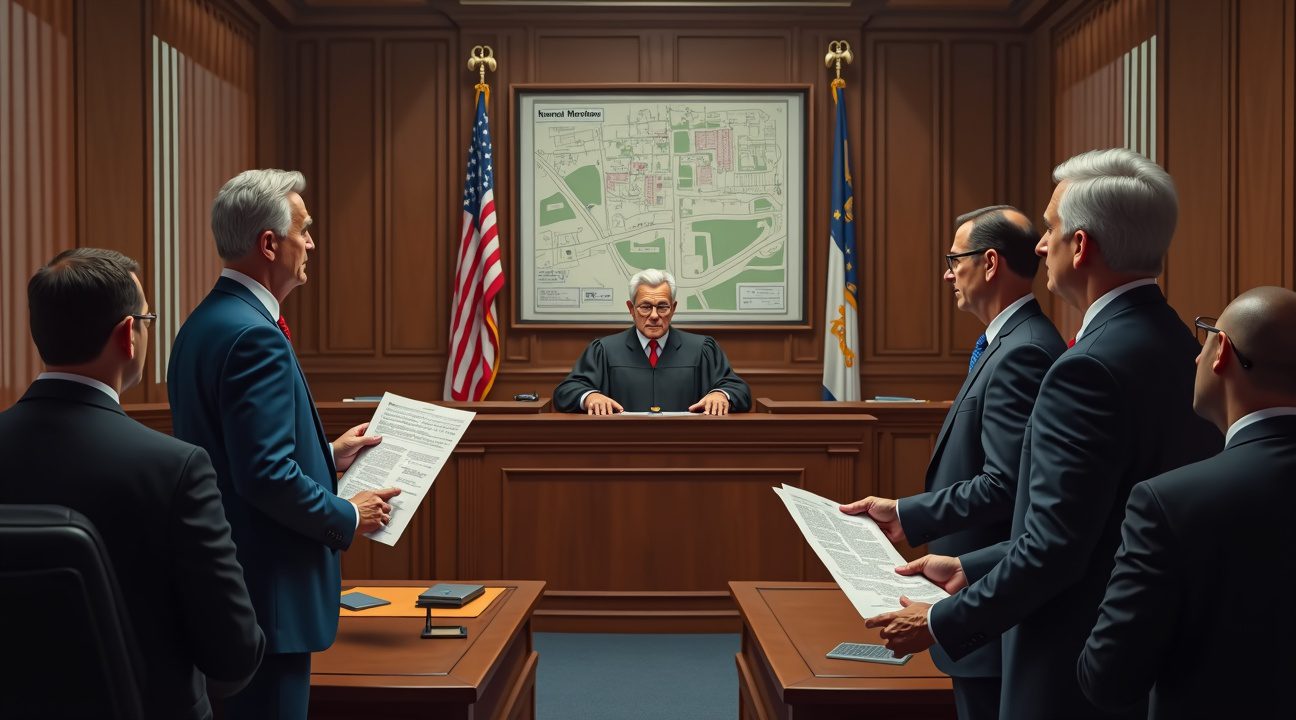Jason Fauntleroy believed he had secured a great deal when he spent $5,000 on what was supposed to be a vacant lot at a 2021 sheriff’s auction, but the reality was far more complex and costly.
Unexpected Ownership Comes With Hidden Costs
At the Butler County Sheriff’s Office auction, Fauntleroy thought he was purchasing a simple parcel of undeveloped land. However, records show that instead of a vacant lot, he acquired an entire private street with five existing homes — a discovery that introduced serious complications. Rather than development potential, he inherited a property with heavy responsibilities.
Key Challenges Fauntleroy Faced
- Significant Liabilities: Fauntleroy was now responsible for maintenance tasks like snow removal and road repairs, along with exposure to potential legal claims.
- Lack of Development Potential: Since the street is the sole access point for current homeowners, he couldn’t build or sell without addressing their legal rights first.
- No Market Appeal: Selling the street became impossible due to the surrounding residential use, severely limiting options to recover his investment.
City Intervention via Eminent Domain
After three years of unsuccessful discussions with the City of Trenton, Fauntleroy found himself ensnared in a legal process. The city, unwilling to take on the costs of street maintenance without ownership, opted to reclaim the property through eminent domain. Compensation, however, was only offered based on the original intended purchase of a vacant lot — not the expanded scope of what Fauntleroy unintentionally acquired.
Lessons From a Troubling Sale
Key Takeaways
- Fauntleroy unintentionally bought a private street with homes, not a vacant lot.
- The unexpected ownership placed major financial and legal burdens on him.
- The street could not be redeveloped due to access rights of current residents.
- Trenton used eminent domain to reclaim the street, offering limited compensation.
- This incident underscores the critical importance of verifying property information before participating in government auctions.
This case serves as a cautionary tale about the potential pitfalls in public property auctions, where administrative errors and ambiguous listings can turn a bargain into a costly legal ordeal.
$5,000 Auction Bid Turns Into Ownership of Entire Private Street
Jason Fauntleroy walked into a Butler County Sheriff’s Office auction in 2021 with a simple plan: purchase a vacant lot for $5,000 where he could build his dream home. The auction seemed straightforward, and his winning bid felt like a solid investment in his future. Little did he know that his modest purchase would transform him from a hopeful homeowner into the unlikely owner of an entire private street.
The Shocking Discovery
After completing the paperwork and receiving official documentation, Fauntleroy made a startling discovery. His $5,000 investment hadn’t just secured him a vacant lot on Bloomfield Court – he’d actually purchased the entire private street itself, complete with five existing homes lined along its length. The auction listing had bundled the street with the lot, but this crucial detail wasn’t clearly communicated to bidders.
The revelation came as a complete surprise to Fauntleroy, who had attended the auction with clear intentions to buy property for residential construction. Instead of becoming a homeowner-to-be, he found himself in the unusual position of owning the road beneath his neighbors’ feet. City officials couldn’t provide an explanation for how such a significant oversight occurred in the auction listing process.
This unexpected turn of events highlights the importance of thoroughly reviewing auction documentation before bidding. Property auctions can sometimes include surprising elements that aren’t immediately apparent from basic listings. Fauntleroy’s experience serves as a reminder that what appears to be a simple real estate transaction can sometimes involve much more than anticipated.
The incident raises questions about transparency in government auctions and the responsibility of auction organizers to clearly communicate what buyers are actually purchasing. While Fauntleroy’s situation is certainly unusual, it demonstrates how small oversights in official documentation can lead to significant misunderstandings with lasting consequences for all parties involved.

From Dream Home to Maintenance Nightmare
Fauntleroy’s accidental street purchase transformed what should have been a straightforward property investment into an expensive ongoing responsibility. Owning Bloomfield Court meant he suddenly became liable for every aspect of street maintenance, from winter snow removal to costly asphalt repairs that could run thousands of dollars annually.
Unexpected Legal and Financial Obligations
The liability issues proved particularly concerning, as Fauntleroy now faced potential lawsuits for any accidents or injuries occurring on his private street. Property insurance costs increased significantly to cover these expanded risks, while local regulations required him to maintain the road to municipal standards despite receiving no tax revenue or municipal support.
An Unsellable Asset with No Development Options
Development dreams quickly crumbled when Fauntleroy discovered the harsh reality of street ownership. Building on Bloomfield Court wasn’t legally possible since the road serves as the sole access route for five existing residences. Blocking or modifying the street would cut off these homeowners, creating immediate legal conflicts and making any construction plans impossible.
The financial frustration deepened when he learned that raw land in the area typically sells for approximately $80,000 per acre. His street, while technically valuable land, couldn’t be subdivided, developed, or sold to developers interested in building new homes. The existing residents held effective veto power over any changes since they needed guaranteed access to their properties.
Attempts to sell the street proved equally challenging. Potential buyers quickly realized they’d inherit all maintenance responsibilities without gaining any practical benefits. The five homeowners had no incentive to purchase the street collectively, as they already enjoyed free access under the current arrangement. Real estate agents struggled to market the property, as traditional buyers couldn’t use it for residential construction and commercial developers found no viable business model.
The ongoing costs continued mounting while Fauntleroy searched for solutions. Winter maintenance alone required hiring snow removal services for the entire street length. Pothole repairs, drainage issues, and eventual resurfacing projects would all fall under his financial responsibility. These expenses accumulated without any corresponding income potential, creating a perfect storm of financial liability disguised as property ownership.
His situation highlighted the critical importance of thorough due diligence before any real estate purchase, particularly when dealing with unusual property types that might not fit standard residential or commercial categories.

City Initiates Eminent Domain After Failed Negotiations
After three years of unsuccessful negotiations between Fauntleroy and the City of Trenton, municipal officials decided to exercise their eminent domain authority to reclaim the street and restore public access. This legal process allows government entities to acquire private property for public use, even when property owners refuse to sell voluntarily.
Controversial Compensation Offer Sparks Legal Dispute
The city’s approach to compensation became the central point of contention in this unusual case. Municipal appraisers determined the value based solely on the vacant lot portion of Fauntleroy’s purchase, completely disregarding the street itself. This selective valuation strategy effectively treated the street as worthless, despite Fauntleroy holding clear legal title to both components of his property.
Ohio’s eminent domain statutes require “just compensation” at fair market value for any property taken through government action. However, Fauntleroy challenged the city’s appraisal methodology, arguing that their offer constituted an unfair attempt to reclaim valuable public infrastructure without proper payment. The property owner maintained that excluding the street’s value from compensation calculations violated his constitutional rights under both state and federal law.
The compensation dispute highlighted fundamental questions about property valuation in unusual circumstances. While vacant lots have established appraisal methods, determining fair market value for a purchased street presents unique challenges. Fauntleroy’s legal team argued that the street carried inherent value as developable land with existing infrastructure, utilities, and access rights.
Municipal officials defended their position by claiming the street held no independent market value separate from the vacant lot. They contended that Fauntleroy’s original purchase was essentially an administrative error that shouldn’t result in windfall profits at taxpayer expense. City attorneys argued that compensating for the street’s full value would set a dangerous precedent encouraging speculative purchases of public property through legal loopholes.
The disagreement over compensation methods revealed broader tensions between property rights and municipal authority. Fauntleroy accused the city of attempting to recover their mistake without bearing the financial consequences of proper legal procedures. He maintained that government entities shouldn’t be able to undo property transactions simply because they prove inconvenient or expensive to resolve.
This compensation controversy also raised questions about due diligence responsibilities in property transactions. While Fauntleroy conducted what he believed was appropriate research before purchasing, the city argued that reasonable buyers should recognize when property descriptions seem too unusual or valuable for the listed price.
The eminent domain process typically involves court oversight to ensure fair compensation, but initial city offers often serve as starting points for negotiation rather than final settlements. Property owners can challenge both the taking itself and the proposed compensation through judicial review. Fauntleroy’s case presented courts with the unusual task of determining appropriate compensation for property that arguably shouldn’t have been sold to private buyers in the first place.
Legal experts noted that this situation demonstrated potential gaps in property transfer oversight systems. When public infrastructure accidentally enters private ownership, resolving the error requires balancing legitimate property rights against public interests and taxpayer costs. The compensation dispute reflected these competing priorities, with each side claiming legal and moral justification for their position.
The three-year negotiation period indicated both parties’ recognition of the case’s complexity and potential precedent-setting implications. Neither side wanted to establish unfavorable legal standards that might affect future similar situations. The city sought to minimize financial exposure while Fauntleroy demanded full compensation for his documented property ownership rights, creating an impasse that ultimately required judicial intervention to resolve.

Legal Precedent and Property Rights Protection in Ohio
Fauntleroy’s situation reflects decades of Ohio legal precedent that strongly favors property owners against government overreach. I’ve observed how this state consistently protects individual property rights, particularly in cases where municipal authorities attempt questionable takings or fail to provide adequate transparency in property transactions.
The foundation for Ohio’s property protection stance stems from landmark cases like City of Norwood v. Horney, which established crucial protections against unfair government valuation practices. This case demonstrated how Ohio courts prioritize individual property rights over municipal convenience, setting a standard that continues to influence property disputes today. Courts in Ohio have repeatedly shown they won’t tolerate government entities that attempt to circumvent proper procedures or fail to honor legitimate property acquisitions.
Communication Breakdown and Administrative Accountability
The breakdown in communication between Fauntleroy and city officials represents a concerning pattern I’ve seen in similar property disputes across Ohio. When property owners report being blocked and ignored by municipal authorities, it often signals deeper systemic issues within local government operations. These communication failures frequently escalate minor administrative problems into major legal battles that could have been resolved through proper dialogue.
Ohio’s legal framework specifically addresses situations where government entities fail to engage in good faith negotiations with property owners. The state’s courts have consistently ruled that municipalities cannot simply ignore property owners or refuse to acknowledge legitimate ownership claims. This principle extends beyond eminent domain cases to include situations involving unclear property listings, auction irregularities, and homeowner association dissolutions.
Real estate auctions in Ohio face increasing scrutiny due to cases like Fauntleroy’s, where the transparency of property listings comes into question. I’ve noticed that courts are demanding higher standards for disclosure and clarity in public property sales. When auction descriptions fail to accurately represent what’s being sold, courts typically side with buyers who can demonstrate they acted in good faith based on available information.
The dissolution of homeowner associations adds another layer of complexity to property rights disputes in Ohio. When these organizations abandon their responsibilities, individual property owners often find themselves dealing directly with municipal authorities who may lack proper understanding of the property arrangements. Ohio law requires clear transfer of responsibilities when homeowner associations dissolve, but enforcement of these requirements isn’t always consistent.
Fauntleroy’s case also highlights how Ohio courts approach situations where multiple parties share responsibility for property management confusion. The state’s legal system tends to place the burden of clarity on the entity with greater resources and authority rather than on individual property owners who rely on official documentation. This approach protects citizens from bearing the consequences of administrative failures they didn’t cause.
The broader implications of this case extend to how Ohio handles property rights in transitional neighborhoods and areas undergoing development changes. Courts have shown they won’t allow municipal authorities to use administrative confusion as a way to avoid honoring legitimate property transactions. This protection becomes particularly important in areas where property values are changing rapidly or where development pressures create incentives for municipalities to reclaim privately owned land.
Ohio’s emphasis on protecting private property owners reflects a fundamental understanding that clear property rights serve as the foundation for economic stability and community development. The state’s courts recognize that when property owners can’t trust the accuracy of official documents and auction listings, it undermines confidence in the entire real estate system. This recognition drives consistent rulings that favor property owners who can demonstrate they followed proper procedures based on the information provided to them.
https://www.youtube.com/watch?v=ODYXBQ9QmLY
Sources:
Real Estate Report, “Man Accidentally Buys Entire Street for $5,000 – YouTube”
GOOD, “He accidentally bought an entire street for $5,000. The city’s …”
EN AS, “The man who buys an entire street for $5,000 without realizing it and …”
WCPO 9, “This man bought a street, and the city wants it back – YouTube”
Unilad, “City issues update after US man accidentally buys entire street for $5,000”
Scoop Upworthy, “US man accidentally buys entire street for $5,000 instead of a vacant …”


